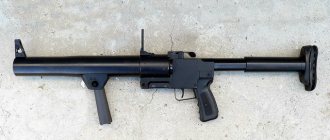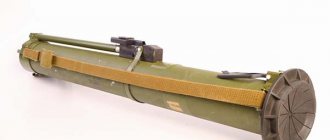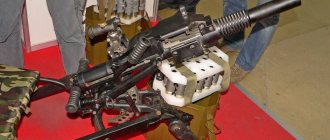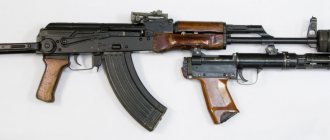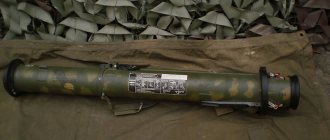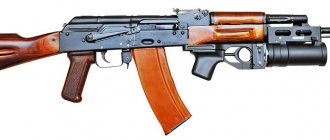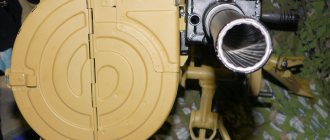| 30×29 mm | |
| 30 mm VOG-17M round and 7.62×39 mm intermediate cartridge | |
| Chuck type | grenade launcher shot |
| Manufacturer country | USSR |
| Cartridge | 30×29 mm |
| Type of weapon using cartridge | AGS-17, AGS-30 . |
| Service history | |
| Operating time | 1971 - present V. |
| Used | USSR, Russia, Bulgaria, Serbia |
| Wars and conflicts | Afghan war (1979-1989), war with the Contras, armed conflicts in the post-Soviet space, Civil War in Syria |
| Production history | |
| Time of creation | 1960s |
| Years of production | 1960s - present V. |
| Options | VOG-17A, VOG-17M, VOG-30, GPD-30, VUS-17, as well as Bulgarian and Serbian copies |
| Characteristics | |
| Cartridge weight, g | 350 |
| Chuck length, mm | 132 |
| Real bullet caliber, mm | 30 |
| Bullet weight, g | 280 |
| Initial bullet speed, m/s | 185 |
| Sleeve parameters | |
| Sleeve length, mm | 28 |
30×29 mm
- Russian grenade launcher shot.
Story
The VOG-17 round was developed at the Basalt research and production association in the late 1960s as ammunition for the AGS-17 automatic grenade launcher. Mechanical fuses for VOG-17, VOG-30 rounds and modifications were developed by the Scientific Research Technological Institute in Balashikha[1].
A unique surgical operation to remove a fragmentation grenade of this type (which entered the soldier’s chest and was cocked, but did not explode) was successfully carried out by a graduate of the Barnaul Medical Institute, captain of the medical service A. M. Melnikov[2].
GPD-30
GPD-30 stands for extended action (or range) grenade. To increase the combat effectiveness of automatic grenade launchers, in the late 1990s it was decided to create a new third-generation ammunition. In 2005, the grenade was adopted by the Russian army. The grenade received a new body with higher aerodynamic properties, which increased the flight range (from 1700 to 2100 meters), reduced flight time, and reduced the influence of wind. The A-IX-1 explosive was replaced with A-IX-2, which is 15-20% more powerful, further increasing the power of explosions and the force of fragments. Instead of a copper belt, there are 2 rings (similar to piston rings) on the grenade body.
Modifications of 30-mm VOG shots of the Russian Federation and foreign samples:
- VOG-17A - fragmentation shot of the first releases. The body of the shot is painted black;
- VOG-17M is a modernized VOG-17A shot. It has a modified VMG-M fuse with a 25-second self-destruct if it does not explode on the target. The body of the shot is painted black. VOG-17MU-fragmentation shot;
- VUS-17 - special training shot. Designed for target practice. Does not contain explosives. Upon impact, orange smoke is produced, which exits through several holes in the charge housing;
- VOG-30 - fragmentation grenade launcher shot. An improved version of VOG-17A/VOG-17M, it has a higher damaging fragmentation effect. The body of the shot is gray;
- VUS-30 - special training shot. Designed for target practice. Creates a cloud of red-yellow smoke, smoke generation time is 10-15 seconds;
- GPD-30 is a grenade with increased action (or range). It is distinguished by an increased shot range and high destructive fragmentation effect. The body of the shot is painted gray;
- VOG-17 LAF (GRAU index - 7P10) - monitor shot;
- VOG-17M LAF (GRAU index – 7П10М) – monitor shot;
- RHV-HEF - Bulgarian weapons fragmentation round;
- RHV-TP - training round of the Bulgarian weapons;
- T-M93P1 - Serbian weapons fragmentation round;
- VG-M93 - Serbian weapons training shot;
- VMG-M93 training shot-marker of the Serbian arms.
Technical characteristics of VOG shots
| TTX | VOG-17 | VOG-17M | VOG-30 | GPD-30 |
| Shot weight (kg) | 0,35 | 0,348 | 0,348 | 0,34 |
| Grenade weight (kg) | 0,28 | 0,275 | 0,275 | 0,275 |
| Weight of explosives (kg) | 0,036 | 0,036 | 0,04 | 0,036 |
| Initial speed (m/s) | 185 | 185 | 185 | 185 |
| Caliber (mm) | 30 | 30 | 30 | 30 |
| Shot length(mm) | 132 | 132 | 132 | 132 |
| Sleeve length (mm) | 28 | 28 | 28 | 28 |
| Grenade length (mm) | 113 | 113 | 113 | 113 |
| Sleeve flange diameter (mm) | 31,9 | 31,9 | 31,9 | 31,9 |
| Sleeve Protrusion Flange Diameter (mm) | 32,6 | 32,6 | 32,6 | 32,6 |
| Damage area (m2) | 70 | 70 | 110 | 130 |
| Damage radius (m) | 6 | 6 | 6 | 6 |
| Shot range (m) | 1700 | 1700 | 1700 | 2200 |
| Method of defeat | high explosive | high explosive | high explosive | high explosive |
Description
The VOG-17A and VOG-17M rounds consist of a fragmentation grenade, a powder/propellant charge and an instantaneous head fuze.
The body of the grenade is thin-walled steel, chemically blackened, inside the body there is a fragmentation jacket with semi-finished fragments (a spiral of notched wire of rectangular cross-section).
The powder charge of the VOG-17A shot is intended to impart initial speed to the grenade. It consists of a cartridge case, an igniter primer and nitroglycerin powder.
The head impact fuse serves to explode the grenade when it meets the target. The head fuse consists of impact (inertia) and ignition mechanisms and a long-range cocking safety mechanism.
The fuse is cocked at a distance of 10-60 m from the muzzle of the grenade launcher, which provides additional safety when firing.
VOG-17A and VOG-17M grenades in combat equipment are painted black.
Shot device
VOG grenade launcher rounds consist of three main parts: VMD-M (modified multi-link fuse), a fragmentation body (in VOG-17 there is a fragmentation jacket made of wire with semi-finished elements) inside which there is an explosive, a cartridge case with a powder charge. VMD-M is designed to detonate a grenade when it hits a target (wall, ground, etc.), the fuse has a fuse that cocks the fuse into firing position 10-30 meters after the shot. The fuse ensures safety during transportation and storage of charges, as well as in the event of a grenade accidentally hitting an obstacle (post, tree, fence) in the immediate vicinity of the grenade launcher and its crew. VMD-M also has a self-destruct mechanism after about 25 seconds, if the striker does not hit the fuse. The housing is used to create fragments and store explosives (A-IX-1). There is a copper belt on the body, which serves for better obturation (clogging-tightness) of the grenade during a shot, as well as for imparting rotation along the axis while moving along the barrel of the grenade launcher. The sleeve serves to hermetically store the powder charge, which is used for the shot itself (giving initial speed); the capsule is located in the sleeve.
Ammunition types
Several variants of 30 mm rounds have been developed and produced:
- VOG-17A
(index 7P36) - a fragmentation grenade with a VMG instantaneous fuse - one of the first, now outdated, modifications.
The grenade body is painted black. Also produced in Bulgaria under the name 30 mm HE Round IO-30
[3] - VOG-17M
is a modernized version of VOG-17A from 1971. The VMG-M fuse is equipped with a self-destruct device, the moderator is designed for 25 seconds. The grenade body is painted black. - VOG-17MU
- fragmentation grenade[4] - VOG-30
- an improved version, developed in the 1980s, has a more powerful fragmentation effect, as well as autonomous sealing of the propellant charge in the cartridge case - GPD-30
is a new type of fragmentation grenade, developed since 1999 by TsKIB SOO[5][6]$ The VOG-30D shot increased the firing range by 25%, due to optimization of the aerodynamic shape of the grenade[7]. - VUS-17
is a practical shot, instead of a charge it is equipped with a pyrotechnic composition of orange smoke, indicating the location of the grenade landing. - training shot
- used for training in weapon operations, does not have equipment. The grenade and cartridge case are additionally fastened with an axial screw to prevent dismantling of the cartridge as a result of repeated manipulations during official handling. A blank bushing is screwed into the end of the grenade, repeating the shape and dimensions of the fuse. - RHV-HEF
- shot produced by Bulgarian [8] - RHV-TP
- shot produced by Bulgarian [8] - T-M93P1
- shot produced by Serbian [9] - VG-M93
- Serbian-made training shot (with inert ammunition)[9] - VMG-M93
- training shot-marker produced by Serbian [9]
Shot VOG-17 (VOG-17A) / VOG-17M / VOG-30 / GPD-30
| VOG-17 |
At the end of the 1960s, the Pribor design bureau developed a 30-mm VOG-17 (VOG-17A) round with a fragmentation grenade (index 7P36) for firing from the AGS-17 grenade launcher.
Soon the VOG-17A round was modified and put into service with the designation VOG-17M. The VOG-17M shot with a VMG-M instantaneous fuse differs from the VOG-17A in a fuse equipped with a self-destruct device.
VOG-17 (VOG-17A)
The VOG-17A and VOG-17M rounds consist of a fragmentation grenade, a powder charge and an instantaneous head fuze (IMG).
The VOG-17A fragmentation grenade is intended to destroy manpower with fragments. It consists of a body, a driving belt, a fragmentation jacket with semi-finished elements in the form of a spring made of cut wire and a bursting charge weighing 56 g.
The increased efficiency of the fragmentation effect of the VOG-17M round is ensured by fragments of a given shape and optimal mass, formed by corrugation on the inner surface of the grenade body, obtained by cold stamping.
The powder charge of the VOG-17A shot is intended to impart initial speed to the grenade. It consists of a cartridge case, an igniter primer and nitroglycerin powder.
The propellant charge of the VOG-17M shot, due to additional autonomous sealing, functions reliably under all operating conditions in various climatic zones.
The head impact fuse ensures reliable operation of grenades when encountering various targets (obstacles), including snow, swamps and water surfaces. It consists of impact and ignition mechanisms and a long-range cocking safety mechanism. The impact mechanism ensures that the fuse is triggered when it encounters an obstacle. The ignition mechanism ensures that the safety mechanism is activated. The long-range cocking safety mechanism ensures the safety of the fuse during official handling and long-range cocking. The fuse mechanisms are located in a sleeve with an axis that presses the membrane. The fuse is cocked at a distance of 10 - 30 m from the muzzle of the barrel.
The weight of the VOG-17A shot is 0.35 kg, grenades - 0.28 kg, explosives - 0.36 kg.
The initial speed of the grenade is 185 m/s. The average maximum gas pressure is no more than 123 MPa. Shot length - 132 mm, cartridges - 28 mm, grenades - 113 mm. The diameter of the sleeve flange is 31.9 mm, the protrusion flange is 32.6 mm. The radius of continuous destruction by lethal grenade fragments is at least 7 m with a probability of destruction of 0.9. VOG-17M
The VOG-17M round has a fuse with a self-destructive device. The self-destruct mechanism is activated when fired; its pyrotechnic retarder is designed for 25 seconds. The self-destructor does not depend on the fuse target sensor and neutralizes the grenade if the main fuse does not go off for any reason within a given time. The mass of the VOG-17M shot is 0.348 kg, the grenade is 0.275 kg, the explosive charge is 0.036 g, the affected area is 70 square meters. m. The initial speed of the grenade is 185 m/s. The average maximum gas pressure is no more than 123 MPa. Shot length - 132 mm, cartridges - 28 mm, grenades - 113 mm. The diameter of the sleeve flange is 31.9 mm, the protrusion flange is 32.6 mm.
VOG-17A and VOG-17M grenades in combat equipment are painted black. The fully loaded shots are placed in paper cartridges and placed in sealed metal boxes of 48 pieces. Two of these boxes with shots are placed in wooden boxes.
In addition to combat fragmentation rounds, there is also ammunition for auxiliary purposes.
To teach how to operate a weapon, training shots that do not have any equipment are used.
The grenade and cartridge case are additionally fastened with an axial screw to prevent dismantling of the cartridge as a result of repeated manipulations during official handling. A blank bushing is screwed into the end of the grenade, repeating the shape and dimensions of the fuse. VUS-17
For training shooting, practical shots are used, designated VUS-17. They differ from combat ones only in that instead of an explosive charge, grenades are equipped with a pyrotechnic composition of orange smoke, indicating the location of the grenade's impact. The grenade does not have a fragmentation jacket, and the walls of the grenade body are thickened.
To distinguish practical grenades from combat grenades, in addition to the inscription VUS-17 (instead of VOG-17M) and the absence of the BB index, a red ring stripe is additionally applied to the VUS-17 housings.
VUS-17 grenades come in two types - with two symmetrical holes on the body between the centering bulges, and without holes. The holes facilitate the escape of smoke and, in addition, can serve as an additional distinctive feature of a practical shot.
In the 1980s, the Pribor State Research and Production Enterprise developed a new VOG-30 shot for 30-mm automatic grenade launchers, the fragmentation efficiency of which is 1.5-2 times higher compared to the VOG-17A, while significantly simplifying the grenade design.
The VOG-30 round is an improved type of ammunition that has a more powerful fragmentation effect due to the use of a new method of manufacturing the body using the method of volumetric cold deformation with the formation of semi-finished fragments on its inner surface. In addition, the VOG-30 uses autonomous sealing of the propellant charge in the cartridge case. There is no fragmentation jacket as a separate part in the VOG-30.
The weight of the VOG-30 shot is 0.348 kg, grenades - 0.275 kg, explosives - 0.40 kg. The initial speed of the grenade is 185 m/s. The average maximum gas pressure is no more than 123 MPa. Shot length - 132 mm, cartridges - 28 mm, grenades - 113 mm. The diameter of the sleeve flange is 31.9 mm, the protrusion flange is 32.6 mm. The affected area is 110 m².
The fuses of all types of VOG grenades are cocked at a distance of 10 - 60 meters from the muzzle of the grenade launcher, which provides additional safety when firing.
GPD-30
At the end of 1999, a branch of KBP - TsKIB "SOO" began work on creating a 30-mm grenade launcher round of a new generation - GPD-30. The drag coefficient and ballistic coefficient of the grenade were reduced by 1.8 times. As a consequence of this, in comparison with standard shots: - the grenade range has been increased to the required value (from 1700 to more than 2100 m); — accuracy indicators have been improved by 1.4 times, both in the lateral direction and in range; — the grenade’s sensitivity to longitudinal and side winds has been reduced by 1.5-2 times; — the flight time of the grenade has been reduced by 1.4 times at a comparable range of 1700 m.
During field comparative tests of the VOG-17, VOG-30 and GPD-30 rounds, it was noted that the lowest brightness, the size of the muzzle flame and the absence of a back flame are observed on the GPD-30 round, which reduces the possibility of detecting the firing position.
For the new shot, a fundamentally new method of manufacturing the grenade body was used. Like the body of the VOG-30 grenade, the body of the GPD-30 is manufactured using the volumetric deformation method, but with the formation of a fragmentation mesh of a rhombic profile on its inner surface, in which all sides of an individual fragmentation element are oriented relative to the texture of the cold-worked body at a certain angle.
The affected area of the GPD-30 grenade over the entire range of impact angles exceeds the similar indicators of the VOG-30 grenade both when firing at unprotected manpower and at manpower in body armor.
Based on the results of calculating the efficiency indicators of the "Granade launcher AGS-17 - Shot VOG-30" complex and the alternative complex "Granade launcher AGS-30 - Shot GPD-30" developed at KBP, it was found that with an equal total mass of grenade launchers and ammunition, the use of the latter complex in Overall, it increases efficiency by more than 1.4 times.
Increased firing safety of the GPD-30 is ensured by equipping the shot with a fuse that has a safety type design and a minimum cocking range increased from 10 to 20 m.
GPD-30 shot weight - 0.34 kg, shot length - 132.3 mm, grenade weight - 0.275 kg, initial grenade speed - 185 m/s, maximum firing range - 2200 m, reduced fragmentation area of targets with Eu = 10 kgf/cm² - 130.5 m².
The "AGS-30 grenade launcher - GPD-30 shot" complex is mass-produced and can be supplied in any quantities.
Operation of parts and firing mechanisms for a grenade launcher
Before the shot is fired, the sting of the impact mechanism of the fuse rests with its flange against the flap of the safety mechanism, which is kept from turning by a stopper, and therefore it cannot puncture the detonator cap. When a shot is fired, the impact of the bolt striker on the primer-igniter of the powder charge explodes the primer composition and ignites the powder charge. The gases formed during the combustion of the powder charge eject the grenade from the barrel. When fired, the igniter capsule of the ignition mechanism of the fuse, under the influence of inertial force from the linear acceleration of the grenade, compresses the spring and is impaled on the sting. A ray of fire from the igniter capsule through a hole in the sleeve with the axle ignites the powder composition of the safety mechanism, which, at a distance of 10-30 m from the muzzle of the grenade launcher barrel, finishes burning, and the stopper, freed from the powder composition and rising under the action of a spring, releases the valve; the damper, turning under the action of a rotary spring and centrifugal force, opens the way for the sting of the impact mechanism. When it encounters a target (obstacle), the membrane with the cap, deforming, advances the rod with the sting of the impact mechanism and the sting pierces the detonator capsule, which explodes and causes the explosive charge of the grenade to explode. At the same time, the spring and body of the grenade are crushed into fragments, which hit the enemy’s manpower.
Grenades and IEDs based on VOG-17
Due to the prevalence and relative ease of availability of VOG-17 ammunition during the First and Second Chechen Wars, they began to be used by representatives of illegal armed groups as improvised explosive devices (IEDs). Ironically named "khattabka" (or "khattabchik") by Russian military personnel after the famous field commander Khattab, VOG-17 was used as the basis for the manufacture of hand grenades and anti-personnel mines[10]. It is not known why they combined a grenade launcher shot and a grenade fuse, which is always more scarce than the grenade itself; According to some sources, the fuses of training grenades were used, which were not taken into account so strictly[11], according to others - the power is comparable to the RGD-5 with significantly less weight, and you can take more ammunition[12]. IEDs based on VOG-17 were also used by terrorists to mine premises during the terrorist attacks on Dubrovka and Beslan. Subsequently, “khattabki” were found in Syria.
In Bulgaria, they began to produce “hattabkas” industrially under the name AR-ROG - this is a VOG-17 shot equipped with an UZRGM fuse[13]
During the armed conflict in eastern Ukraine, military personnel of the Ukrainian Armed Forces used VOG-17 grenades as anti-personnel mines, and were also dropped from homemade civilian drones[14].
Notes
- Tikhonov S.G.
Defense enterprises of the USSR and Russia: in 2 volumes. - M.: TOM, 2010. - T. 1. - P. 174. - 608 p. — 1000 copies. — ISBN 978-5-903603-02-2. - T. Kutyreva. Surgeon // Border officers. Sat., comp. V. Ya. Goland. M., “Soviet Russia”, 1988. Pp. 229-259
- 30 mm HE Round IO-30 (VOG-17) for Automatic Grenade Launcher AGS-17 // website
- 30-mm postril VOG-17MU Archived copy dated March 5, 2016 on the Wayback Machine // official website of the Ukrspetsexport Group of Companies
- GPD-30, 30 mm grenade launcher round Archived October 5, 2012. // “Weapons of Russia”
- GPD-30 on the Rosoboronexport website
- Russia is recreating forgotten 45 mm caliber shells at a qualitatively new level // RG, 11/8/2021
- ↑ 12
30 mm ARSENAL Automatic Grenade Launcher AGL-30M Archived January 5, 2013. // website - ↑ 123
BGA 30 (unavailable link) - Boris Pribylov, Evgeny Kravchenko, “Hand and Rifle Grenades”, Arctic 4D, ISBN 978-5-902835-04-2, 776 pp., 2008 (Russian)
- Fragmentation grenade "Khattabka". Review, photos, characteristics
- What is “Khattabka” (+ video) // Educational magazine RACCOON
- Arcus AR-ROG defensive hand grenade (Bulgaria) // Jane's
- “It is urgently necessary to focus on the problematic nutritional status of the mine-vibukhov fences and their reception and transmission during the time of change of gastrointestinal units in the areas of the victorious military commands... without any documentary confirmation of installations mine fields, various banners from grenades (F-1, RGD-5, RG-42, VOG-17
, etc.) near checkpoints, strongholds without securing the necessary documents” V. P. Pavlyuchik, I. V. Todavcic. Problems of nutrition and engineering security in the fight against the background of the ATO // Wikipedia on security policy: history and current situation: a collection of testimonies from the International Scientific Conference, June 18-19, 2022. Lviv, NASV, 2022. Page. 90-92
